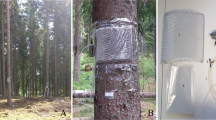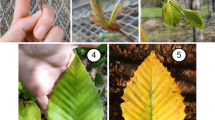Abstract
Leaf and bark volatiles from nonhost angiosperm trees were tested on Ips duplicatus by gas chromatographic–electroantennographic detection (GC-EAD) and by pheromone-baited traps in Sweden and Inner Mongolia, China, respectively. GC-EAD analysis of the headspace volatiles from fresh bark chips of Betula pubescens revealed trans-conophthorin, two green leaf volatiles (GLVs): 1-hexanol and (Z)-3-hexen-1-ol, and two C8 alcohols: 3-octanol and 1-octen-3-ol, that consistently elicited antennal responses by I. duplicatus. The identification of these EAD-active compounds was confirmed in further GC-EAD recordings with synthetic mixtures. Antennal responses were also found to synthetic (E)-2-hexen-1-ol and linalool, which have been identifed from the leaves of nonhost birch and aspen species. No antennal responses of I. duplicatus were found to hexanal, (E)-2-hexenal, and (Z)-3-hexyl acetates. In field trapping experiments, blends of EAD-active green leaf alcohols or C8 alcohols, or trans-conophthorin alone resulted in significant reductions (27–60%) in the number of I. duplicatus captured compared with pheromone-baited traps. The unsuitable host compound, verbenone (Vn), also significantly reduced trap catches by up to 60% in both experiments. The strongest disruptive effect resulted from the addition of the combination of green leaf alcohols, C8 alcohols, and verbenone to the pheromone trap, which caused an 84% reduction in trap catch. The blend of two green leaf aldehydes plus the acetate increased the trap catches in 1998 and had no negative or positive effects in 1999. Our results suggest that these nonhost volatiles (NHVs) are important olfactory signals used by I. duplicatus in host selection. They may have great significance in developing semiochemical-based management programs for I. duplicatus by reducing or stopping attacks on suitable hosts.
Similar content being viewed by others
REFERENCES
ATKINS, M. D. 1966. Behavioral variation among scolytids in relation to their habitat. Can. Entomol. 98:285-288.
BORDEN, J. H. 1997. Disruption of semiochemical-mediated aggregation in bark beetles, pp. 421-438, in R. T. Cardé and A. K. Minks (eds.). Pheromone Research: New Directions. Chapman and Hall, New York.
BORDEN, J. H., CHONG, L. J., SAVOIE, A., and WILSON, I. M. 1997. Responses to green leaf volatiles in two biogeoclimatic zones by striped ambrosia beetle, Trypodendron lineatum. J. Chem. Ecol. 23:2479-2491.
BORDEN, J. H., WILSON, I. M., GRIES, R., CHONG, L. J., PIERCE, H. D., JR., and GRIES, G. 1998. Volatiles from the bark of trembling aspen, Populus tremuloides Michx. (Salicaceae) disrupt secondary attraction by the mountain pine beetle, Dendroctonus ponderosae Hopkins (Coleoptera: Scolytidae). Chemoecology 8:69-75.
BYERS, J. A., and WOOD, D. L. 1980. Interspecific inhibition of the response of the bark beetles, Dendroctonus brevicomis and Ips paraconfusus, to their pheromones in the field. J. Chem. Ecol. 6:149-164.
BYERS, J. A., SCHLYTER, F., BIRGERSSON, G., and FRANCKE, W. 1990. E-myrcenol in Ips duplicatus: An aggregation pheromone component new for bark beetles. Experientia 45:1209-1211.
BYERS, J. A., ZHANG, Q.-H., SCHLYTER, F., and BIRGERSSON, G. 1998. Volatiles from non-host birch trees inhibit pheromone response in spruce bark beetles. Naturwissenschaften 85:557-561.
BYERS, J. A., ZHANG, Q.-H., and BIRGERSSON, G. 2000. Strategies of a bark beetle, Pityogenes bidentatus, in an olfactory landscape. Naturwissenschaften 87:503-507.
DEGLOW, E. K., and BORDEN, J. H. 1998a. Green leaf volatiles disrupt and enhance response to aggregation pheromones by the ambrosia beetle, Gnathotrichus sulcatus (LeConte) (Coleoptera: Scolytidae). Can. J. For. Res. 28:1697-1705.
DEGLOW, E. K., and BORDEN, J. H. 1998b. Green leaf volatiles disrupt and enhance response by the ambrosia beetle, Gnathotrichus retusus (LeConte) (Coleoptera: Scolytidae) to pheromone-baited traps. J. Entomol. Soc. Bt. C. 95:9-15.
DE GROOT, P., and MACDONALD, L. M. 1999. Green leaf volatiles inhibit response of red pine cone beetle Conophthorus resinosae (Coleoptera: Scolytidae) to a sex pheromone. Naturwissenschaften 86:81-85.
DICKENS, J. C., BILLINGS, R. F., and PAYNE, T. L. 1991. Green leaf volatiles: A ubiquitous chemical signal modifies insect pheromone responses, pp. 277-280, in I. Hrdy (ed.). Insect Chemical Ecology. Acadamia Praha, Prague, Czechslovakia.
DICKENS, J. C., BILLINGS, R. F., and PAYNE, T. L. 1992. Green leaf volatiles interrupt aggregation pheromone response in bark beetles infecting pines. Experientia 48:523-524.
GUERRERO, A., FEIXAS, J., PAJARES, J., WADHAM S, L. J., PICKETT, J. A., and WOODCOC K, C. M. 1997. Semiochemically induced inhibition of behaviour of Tomicus destruens (Woll.) (Coleoptera: Scolytidae). Naturwissenschaften 84:155-157.
HUBER, D. P. W., GRIES, R., BORDEN, J. H., and PIERCE, H. D., JR. 1999. Two pheromones of coniferophagous bark beetles found in the bark of nonhost angiosperms. J. Chem. Ecol. 25:805-816.
HUBER, D. P. W., GRIES, R., BORDEN, J. H., and PIERCE, H. D., JR. 2000. A survey of antennal responses by five species of coniferophagous bark beetles (Coleoptera: Scolytidae) to bark volatiles of six species of angiosperm trees. Chemoecology 10:103-113.
LEKANDER, B., BEJER-PEDERSEN, B., KANGA S, E., and BAKKE, A. 1977. The distribution of bark beetles in the Nordic countries. Acta Entomol Fenn. 32:1-100.
LIU, G.-T., LIU, T., and ZHOU, R. 1998. Prediction of occurrences and population tendency of Ips duplicatus Sahlb. by using Markov chain, pp. 258-260, in W.-D. Xu and G.-T. Liu (eds.). Study on Picea mongolica Forest Ecosystem in Baiyinaobao Natural Preserve, Inner Mongolia. China Forestry Publishing House, Beijing.
KNIZEK, M., and ZAHRADNIK, P. 1996. Mass outbreak of Ips duplicatus Sahlberg (Coleoptera: Scolytidae), p. 527, in J. Doe (ed.). Proceedings of the XXth International Congress of Entomology, Firenze, Italy, August 25-31, 1996.
KROKENE, P., and SOLHEIM, H. 1996. Fungal associates of five bark beetle species colonizing Norway spruce. Can. J. For. Res. 26:2115-2122.
PFEFFER, A. 1995. Zentral-und westpaläarktische Borken-und Kernkäfer (Coleoptera: Scolytidae, Platypodidae). p. 310, Pro Entomologia, Naturhistorsches Museum, Basel.
POLAND, T. M., and HAACK, R. A. 2000. Pine shoot beetle, Tomicus piniperda (Coleoptera: Scolytidae), responses to common green leaf volatiles. J. Appl. Entomol. 124:63-69.
POLAND, T. M., BORDEN, J. H., STOCK, A. J., and CHONG, L. J. 1998. Green leaf volatiles disrupt responses by the spruce beetle, Dendroctonus rufipennis, and the western pine beetle, Dendroctonus brevicomis (Coleoptera: Scolytidae) to attractant-baited traps. J. Entomol. Soc. B. C. 95:17-24.
POSTNER, M. 1974. Ips duplicatus, p. 455, in W. Schwencke (ed.). Die Forstschädlinge Europas, 2. Paul Parey, Hamburg.
SCHLYTER, F., and ANDERBRANT, O. 1993. Competition and niche separation between two bark beetles: Existence and mechanisms. Oikos 68:437-447.
SCHLYTER, F., and BIRGERSSON, G. 1999. Forest Beetles. pp. 113-148, in R. J. Hardie and A. K. Minks (eds.). Pheromones of Non-Lepidopteran Insects Associated with Agricultural Plants. CAB International, Wallingford, UK.
SCHLYTER, F., LEUFVéN, A., and BIRGERSSON, G. 1989. Inhibition of attraction to aggregation pheromone by verbenone and ipsenol: Density regulation mechanisms in bark beetle Ips typographus. J. Chem. Ecol. 15:2263-2277.
SCHLYTER, F., BIRGERSSON, G., BYERS, J. A., and BAKKE, A. 1992. The aggregation pheromone of Ips duplicatus and its role in competitive interactions with I. typographus (Coleoptera: Scolytidae). Chemoecology 3:103-112.
SCHLYTER, F., LöFQVIST, J., and JAKUS, R. 1995. Green leaf volatiles and verbenone modify attraction of European Tomicus, Hylurgops, and Ips bark beetles, pp. 29-44, in F. P. Hain, S. M. Salom, W. F. Ravlin, T. L. Payne, and K. F. Raffa (eds.). Behavior, Population Dynamics, and Control of Forest Insects, Proceedings of a Joint IUFRO Working Party Conference-February 1994, Ohio State University, OARDC, Wooster.
SCHLYTER, F., ZHANG, Q.-H., ANDERSON, P., BYERS, J. A., WADHAMS, L., LöFQVIST, J., and BIRGERSSON, G. 2000. Electrophysiological and behavioral responses of pine shoot beetles, Tomicus piniperda and T. minor (Coleoptera: Scolytidae), to non-host leaf and bark volatiles. Can. Entomol. 132:965-981.
SCHLYTER, F., SVENSSON, M., ZHANG, Q.-H., KNIZEK, M., KROKENE, P., IVARSSON, P., and BIRGERSSON, G. 2001. A model for peak and width of signaling windows: Ips duplicatus and Chilo partellus pheromone component proportions-does response have a wider window than production? J. Chem. Ecol. In press.
SCHROEDER, L. M. 1992. Olfactory recognization of nonhosts aspen and birch by conifer bark beetles Tomicus piniperda and Hylurgops palliatus. J. Chem. Ecol. 18:1583-1593.
TØMMERÅS B. Å. 1989. Host selection by odorous compounds from host and non-host trees in bark beetles. Fauna Norv. Ser. B 36:75-79.
TØMMERÅS, B. Å., and MUSTAPARTA, H. 1989. Single cell responses to pheromones, host and non-host volatiles in the ambrosia beetle Trypodendron lineatum. Entomol. Exp. Appl. 52:141-148.
VISSER, J. H. 1986. Host odor perception in phytophagous insects. Annu. Rev. Entomol. 31:121-144.
WHITMAN, D. W., and ELLER, F. J. 1990. Parasitic wasps orient to green leaf volatiles. Chemoecology 1:69-75.
WILSON, I. M., BORDEN, J. H., GRIES, R., and GRIES, G. 1996. Green leaf volatiles as antiaggregants for the mountain pine beetle, Dendroctonus ponderosae Hopkins (Coleoptera: Scolytidae). J. Chem. Ecol. 22:1861-1875.
XU, W.-D., ZOU, C.-J., and LIU, G.-T. 1998. The taxonomy and formation of Picea mongolica. pp. 24-33, in W.-D. Xu and G.-T. Liu (eds.). Study on Picea mongolica forest ecosystem in Baiyinaobao Natural Preserve, Inner Mongolia. China Forestry Publishing House, Beijing.
ZHANG, Q.-H. 2001. Ips duplicatus. In Y. Baranchikov and M. Montgomery, (eds.). Manual of Main Forest Insect Pests in Northern Asia. USDA Forest Service. in press, (In English and Russian).
ZHANG, Q.-H., SCHLYTER, F., and LIU, G.-T. 1995. Spatial distribution, mortality and sex ratio of overwintering Ips duplicatus in a Picea mongolica reserve in Inner Mongolia, China with a diffusion model, pp. 109-122, in F. P. Hain, S. M. Salom, W. F. Ravlin, T. L. Payne, and K. F. Raffa (eds.). Behavior, Population Dynamics, and Control of Forest Insects, Proceedings of a Joint IUFRO Working Party Conference-February 1994, Ohio State University, OARDC, Wooster.
ZHANG, Q.-H., BIRGERSSON, G., ZHU, J.-W., LöFSTEDT, C., LöFQVIST, J. and SCHLYTER, F. 1999a. Leaf volatiles from nonhost deciduous trees: Variation by tree species, season, and temperature and electrophysiological activity in Ips typographus. J. Chem. Ecol. 25:1923-1943.
ZHANG, Q.-H., SCHLYTER, F., and ANDERSON, P. 1999b. Green leaf volatiles interrupt pheromone response of spruce bark beetle, Ips typographus. J. Chem. Ecol. 25:2847-2861.
ZHANG, Q.-H., SCHLYTER, F., and BIRGERSSON, G. 2000. Bark volatiles from non-host angiosperm trees of spruce bark beetle, Ips typographus (L.) (Coleoptera: Scolytidae): Chemical and electrophysiological analysis. Chemoecology 10(2):69-80.
Author information
Authors and Affiliations
Rights and permissions
About this article
Cite this article
Zhang, QH., Liu, GT., Schlyter, F. et al. Olfactory Responses of Ips duplicatus from Inner Mongolia, China to Nonhost Leaf and Bark Volatiles. J Chem Ecol 27, 995–1009 (2001). https://doi.org/10.1023/A:1010395221953
Issue Date:
DOI: https://doi.org/10.1023/A:1010395221953




